|
Click on a picture for a more detailed
image.
|
|
|
| You are here |
|
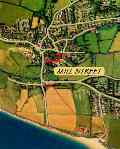 |
|
|
|
|
| Celebrating Queen Victoria's Jubilee 1897.
Despite the crude and rickety archway, the spirit of pride and loyalty
to Her Majesty is strongly indicated among these humble folk. Note
the steam engine chimney dominating the skyline. |
|
 |
| |
|
|
| Another picture of the Jubilee
celebrations in 1897. Mrs Charlotte Payne is 4th in on the right facing
(large lady with apron) possibly her daughter Charlotte at her side. |
|
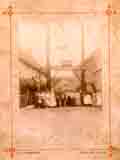 Photo from Helen Doble
Photo from Helen Doble |
|
|
|
|
|
This street is little changed from 1900 when this photo was taken.
The word 'Mill' refers to the extensive spinning and weaving mill
behind the buildings of Shadrach Dairy Farm on the right. The mill
manager's house is at the far end of the street beyond the corrugated
iron roof.
Click on picture for Mill History
|
|
 |
|
|
|
|
| List of Flax Mill workers
in 1891 |
|
Click
here |
|
|
|
|
| The first cottage on the left,
shows no signs in 1930 of what is about to happen - the conversion
to a Post Office, replacing that on the main street.
|
|
 |
|
|
|
| Milk ladled from a churn and
fresh from the cow was the norm in the 1920's. Here, Minnie Thorner
accepts her daily pinta in a jug.
|
|
 |
|
|
|
| The Old Mill House with a
'No Smoking' sign, the adjacent buildings, these being the main office
and workshop of Cheney's garage with a single petrol pump. The old
spinning mill behind had a bell on the roof which tolled daily at
6:30 a.m., the building itself converted from a spinning and weaving
mill to a car workshop. The area is rich in Burton history. |
|
 |
|
|
|
| The Hawkins of Shadrach Dairy
Farm, a well known local family, ran a large herd and delivered milk
daily. Here, Bill Stevenson is on his daily round for Edgar Hawkins.
C. 1930 |
|
 |
|
|
|
| Mill Street C. 1935 visted
by the 'Travelling Shop' - the 'SIXPENNY HALFPENNY BAZAAR'. Identify
as many objects as you can! The idea was taken up by Messrs. Woolworth
in its 3d and 6d shops. Note how housewives mostly wore the obligatory
cotton 'overall' in the '30's. |
|
 |
|
|
|
| Taken around 1940, this shot
shows only modest changes - signs, wires and cables, and a bike outside
what was to eventually become the Post Office.
|
|
 |
|
|
|
| A better view of the orchard
wall, recently torn down by builders to gain access for new houses.
Luckily, the order was to preserve the wall at all costs.
|
|
 |
|
|
|
| This shot shows the Post Office
in its orginal position.
|
|
 |
|
|
|
| Mill Street
|
|
 |
|
|
|
| And this is where the milk round began
- a scene almost the same today in Hawkin's yard, with the church
tower, Mill Terrace and Old Mill House in background. |
|
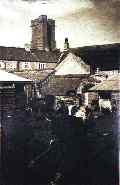 |
|
|
|
| Mill Street C. 1940 |
|
 |
|
|
|
| This quiet scene shows the Mill Street/High
Street junction around 1935. Manor Farm is beyond the distant wall.
The wall on the left enclosed Shadrach Dairy Farm orchard. |
|
 |
|
|
|
| A good view of the cottage (first on left)
before it was converted to a Post Office in 1958. |
|
 |
|
|
|
| Mill Street Cottages |
|
 |
|
|
|
| In the village canteen at Burton Bradstock
(Three Horseshoes), gunner Weightman of the Royal Artillary hands
home made cakes to Corporal James Flower of Walpole, Massachusetts,
Private Roy St. Jean of Springfield in the same state, and Corporal
Allan Decker of Chicago. |
|
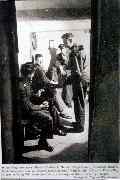 |
|
|
|
| Mill Street as you might see it today
|
|
 |
|
|
|
| The Three Horseshoes as you might see
it today |
|
 |
|
|
|
| The Post Office as you might see it today
|
|
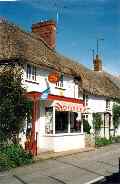 |